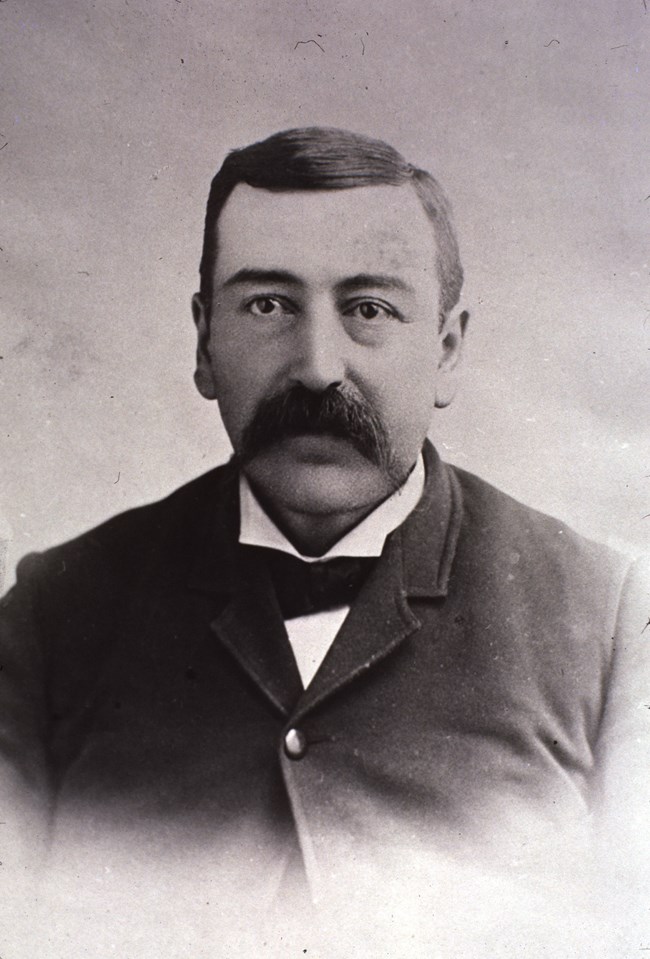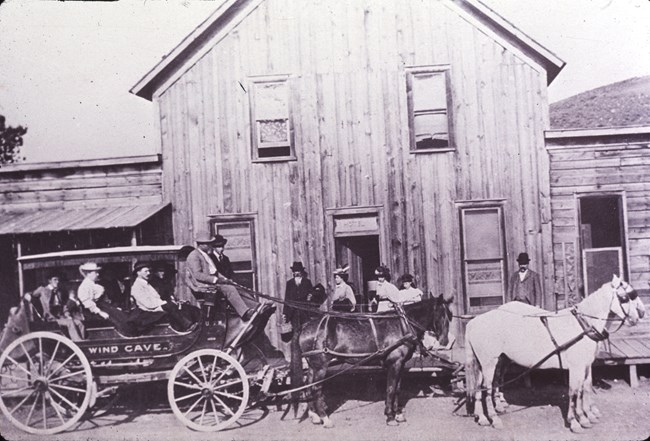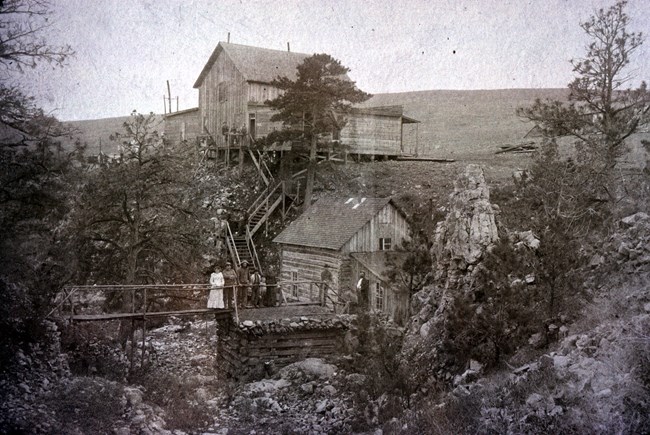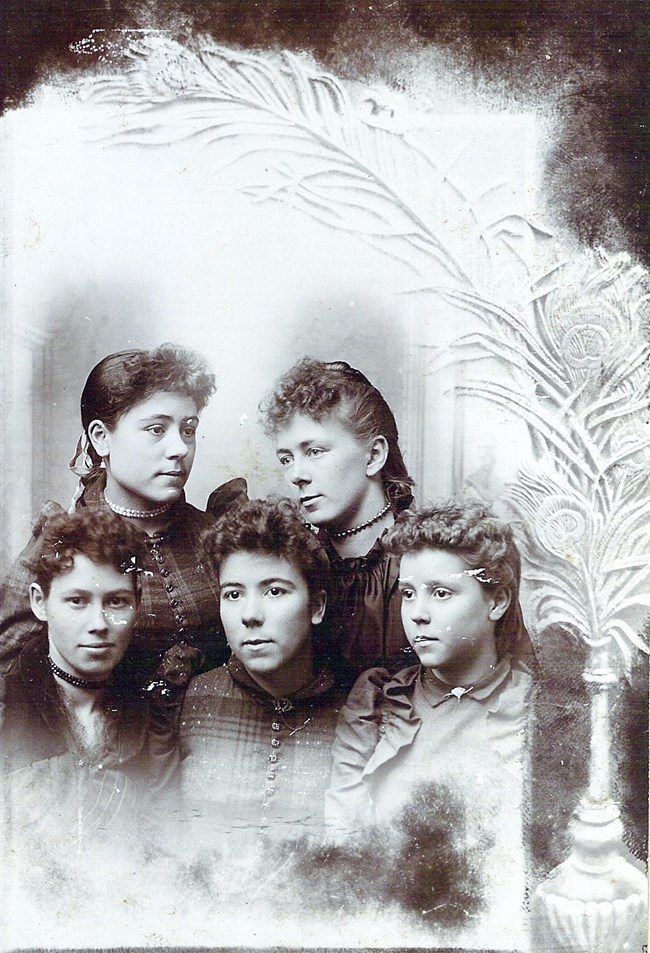
NPS Photo A Mind Reader, A Pin Head, and a Fool; The Story of "Professor" Johnstone's Visit to Wind Cave
Occasionally an event occurs which blossoms into a happening, a story which becomes more than fact; it becomes legend- a legend retold over the years until the distinction between myth and reality is lost. Swallowed by the passage of time, the events, like its participants, fade into history, the myth and reality becoming one. Such is the case of Professor Johnstone's visit to Wind Cave in June of 1893. If newspapers are to be believed, a clairvoyant "Professor" named Paul Alexander Johnstone wagered he would be able to find, while blindfolded, a pin head hidden within the depths of Wind Cave. Newspapers record that he found it after three days, but did they record the facts, or the legend in the making?
This was how the Hot Springs Star introduced Johnstone to the Southern Black Hills. Johnstone claimed to be able to read the mind of a person next to him, thus "seeing" whatever they were seeing. His act in Hot Springs included driving through town and finding names in hotel registers, all the while blindfolded. His amazing powers led to additional performances at the Opera House and within a week of his arrival, Johnstone and his manager, M.E. Rice, ventured out to Wind Cave. The cave's chief guide, 19-year old Alvin McDonald, noted exploring with the two on May 28 and finding eleven new rooms. 
NPS Archive Photo Typically, it was John Stabler, co-manager of the cave, who first broached the idea of a blindfolded hunt. After all, this was the same Stabler who, less than a year earlier, commissioned the construction of a plaster of Paris model of a human figure, which after a miraculous discovery, was exhibited at the cave for a nominal fee as a genuine case of human petrifaction. The comparison of Stabler with our present day perception of a used-car salesman is striking. The guaranteed public appeal of such an undertaking was not lost on Johnstone and Rice, who for immediate monetary reward wagered a local business one thousand dollars Johnstone could find an object hidden in Wind Cave. The object to be hidden would be a golden, scarf pin head made by a jeweler in Hot Springs. From Stabler's point of view, the success of Johnstone's quest was not to be measured by the recovery of the pin head, but by the amount of publicity generated in the excitement.
Realizing a good story also sells newspapers, the Hot Springs Star clarified potential hazards:
Friday's edition of the Star reported:
After spending a long night in the cave, Germond and Boomer returned to Hot Spring Saturday morning. In between accusing each other of being lost, they announced the pin head was hidden five hours into the cave. The undertaking was set to begin on Saturday, June third, but it was delayed a day to await the arrival of H.F. Lancaster, the Elkhorn Railroad photographer out of Omaha. A delay prompting protest from people who felt the hunt was not a "proper observance of the Sabbath." Meanwhile, Johnstone was "kept penned up in his room and was wrought up to a great pitch of excitement until it was hard to keep him quiet." 
NPS Archive Photo After the "light made an impression of the motley scene on the photographer's plate" Sunday morning, the blindfolded Johnstone rushed through the crowd outside
Moore reported it was the most thrilling ride he had ever experienced-with good reason. A normal ride took one and a half to two hours; Johnstone's took fifty-two minutes. The horses used to pull the carriage were the first causalities. One immediately dropped dead upon arrival at the cave, and the other was never any good afterwards. This resulted in Chris Jensen, the team's owner, later suing Johnstone for 75 dollars. 
NPS Archive Photo Entering Wind Cave's hotel, the blindfolded Professor found manager John Stabler in the midst of being shaved by his son George. Johnstone promptly took the razor, warned George not to take his eyes off his father, and proceeded to shave a few strokes, greatly exciting Stabler's family. The circumstances not withstanding, John Stabler later remarked that it was as good a shave as he's ever had in a barber shop. The cave register was signed by all before departing the hotel, the party consisting of Johnstone, McDonald the guide, Moore the correspondent, Boomer and Germond of the committee, and Lancaster the photographer. After making their way down the wooden steps behind the hotel, they disappeared into the cave and into a great amount of speculation concerning the events which transpired over the next three days.
Back in Hot Springs a

NPS Archive Photo
Monday evening things started heating up in Hot Springs:
What some considered Moore's last message was found late Monday or early Tuesday.
Regardless of Johnstone's situation. Stabler could not have planned it better, as the Hot Springs Star reported receiving inquiries from across the nation regarding the quest.
It was early Wednesday morning when Alvin began recognizing where they were in the cave. As the day progressed, they made their way over familiar territory until entering Standing Rock Chamber where
While they waited for a stretcher to be sent down, Johnstone "raved continually, his companion having to wrestle with him to keep him from rushing back into the cave." Years later, Johnstone related:
When the stretcher arrived, Johnstone was carried out as physicians worked to prevent the onset of brain fever, which many felt was likely to develop. They returned to Hot Springs "covered with dirt and tallow drippings" to a triumphant welcome, as "they had been mourned as dead." The feat was hailed as "unquestionably a genuine test of mind reading, as it was impossible for anything savoring a fake to have been attempted." But what really happened? Why did Alvin McDonald never mention the hunt in his diary? By 1893, the diary he had "attended to fairly regularly" had fewer and fewer entries, but he was still recording new discoveries, and none of those involved the Johnstone excursion. Alvin thus neglected mentioning the longest cave trip he ever took, let alone descriptions of the supposedly many new discoveries, and what's more, he apparently never revisited the newly explored areas. Coincidently, he made no mention of Stabler's petrified man a year earlier. While he left with Johnstone for Omaha within a few days, and possibly might have been too busy to immediately record his discoveries, Alvin never mentioned the pin head hunt in his diary before dying from typhoid fever the following winter. 
NPS Archive Photo It is apparent from all the attention they were receiving that sneaking up and sleeping at the hotel each night would have been impossible, but what about supplies being sent down? Katie Stabler wrote years later in her memoirs:
This possibly accounts for "search parties" finding notes and discarded lunch pails indicating Johnstone was not in the cave as deep as newspaper accounts stated. Perhaps it also explains why there have never been any signatures of the group found on cave walls. It was a common practice to write, or smoke, the names of members of groups on the walls or ceilings of rooms they discovered. If they spent a considerable amount of time wandering about in previously unexplored areas of the cave, if they were desperate enough to write "For God's sake, send help," it is surprising they never recorded their presence for searchers, or for documentation of their discoveries. Besides revealing how the party was resupplied from the surface, Katie Stabler also claimed it was not Johnstone that led the party to the room where the pin was hidden, but Alvin McDonald. "They were three days and nights and were getting exhausted, so Alva took them to the place where the pinhead (sic) was hidden." If Stablers were secretly helping Johnstone, why did their good friend and neighbor, Bob McAdam, insist in a 1957 interview Johnstone found the pin head on his own, like the newspapers claimed? Was McAdam not let in on the secret, or was Katie Stabler making false statements? Perhaps we will really never know for sure what happened, or why, instead of extolling the virtues of Johnstone like others did, why did the press correspondent write in the cave register upon arriving back on the surface "John Moore of Johnstone's party, one of the fools." Today you can visit Standing Rock chamber where the quest ended and decide for yourself what happened those three days in June, when Wind Cave captured the attention of the country, and Professor Paul Alexander Johnstone found the pin head. Johnstone later became a medical doctor in Kansas City, Missouri. He died in 1941. Sources
"A Party of Adventurers Lose Their Way in Wind Cave, South Dakota." Omaha Morning World-Herald. 7 June 1893. "Wind Cave Register, 1890-1893." Located at the Wind Cave National Park Museum. The Daily Star. 19 May; 2, 5, 7, 9, 23 June 1893. "He Found the Pin." The Daily Star. 9 June 1893. "Johnstone Himself Again." Omaha World Herald. II June 1893. "Johnstone; The Greatest Feat of the Age Successfully Performed." The Daily Star. 8 June 1893. "Johnstone's Wild Undertaking." The Daily Star. 31 Hay 1893. Koller, Joe. "37 Years Haven't Dimmed Memory of Being Lost in Wind Cave Chamber." Rapid City Journal. II March 1951, p. 24. Moore, John. "His Venture at the Cave." Omaha World Herald. 10 June 1893. Owen, Luella Agnes. 1898. Cave Regions of the Ozarks and Black Hills. New York: Johnson Reprint Corp., 1970. McAdam, Robert and Fannie McAdam. Interview with John Bohi in August of 1957. Tape located at the Wind Cave National Park Museum. McDonald, Alvin F. "The Private Account of A.F. McDonald, Permanent Guide of Wind Cave." Located at the Wind Cave National Park Museum. "The Paul Alexander Johnstone's Wind Cave Story." The Daily Star. 5 February 1897. "Scared About Johnstone; Thirty-One Hours in Wind Cave and Not Returned." Omaha Morning World-Herald, 6 June 1893. Smith, Mrs. George M. and Mrs. Mary Gregory. Interview with John Bohi on 3&7 July 1958. Located at the Wind Cave National Park Museum. Stabler, Katie. "Katie Stabler's Memoirs." Located at the Wind Cave National Park Museum. |
Last updated: September 5, 2023
